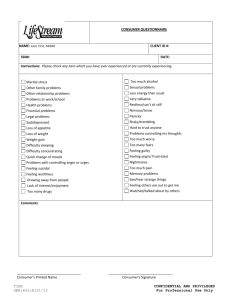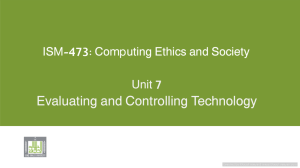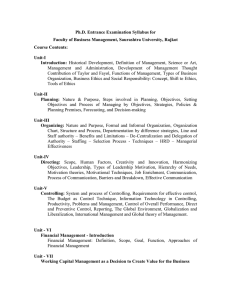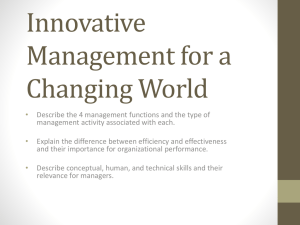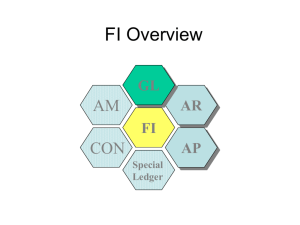Chapter 7: Monitoring and Controlling Projects Learning Objectives
advertisement
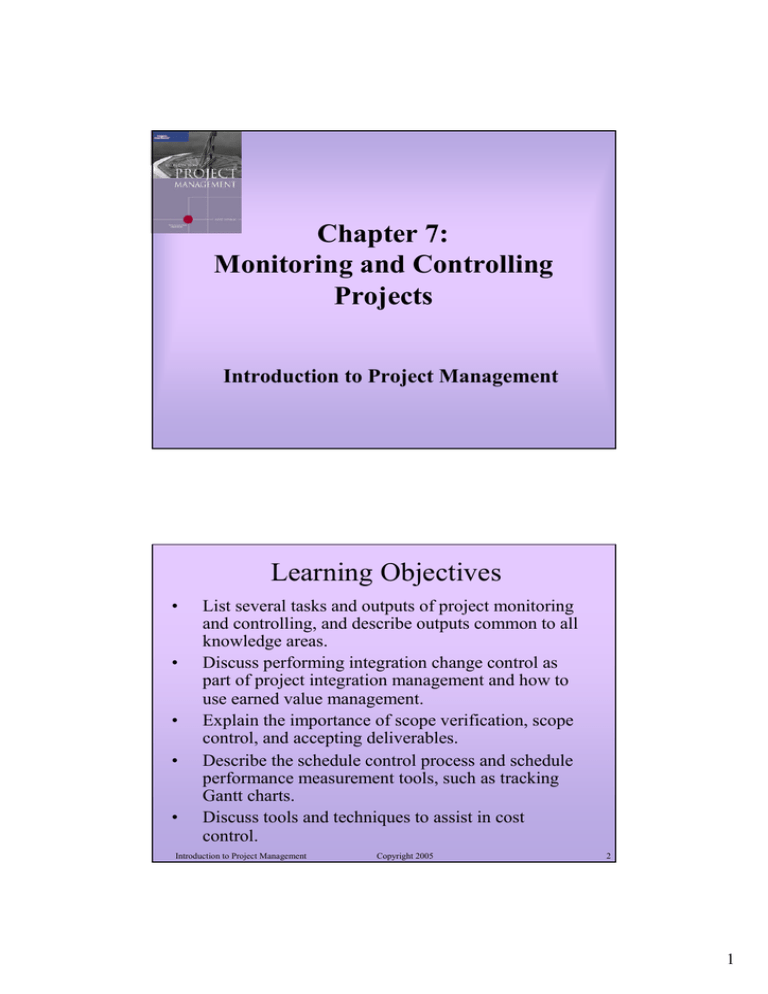
Chapter 7: Monitoring and Controlling Projects Introduction to Project Management Learning Objectives • • • • • List several tasks and outputs of project monitoring and controlling, and describe outputs common to all knowledge areas. Discuss performing integration change control as part of project integration management and how to use earned value management. Explain the importance of scope verification, scope control, and accepting deliverables. Describe the schedule control process and schedule performance measurement tools, such as tracking Gantt charts. Discuss tools and techniques to assist in cost control. Introduction to Project Management Copyright 2005 2 1 Learning Objectives (continued) • List the Seven Basic Tools of Quality, and provide examples of how they assist in quality control. • Explain the monitoring and controlling work done as part of project human resource management to help manage project teams and stakeholders. • Summarize methods for performance reporting and managing stakeholders as part of project communications management. • Describe the risk monitoring and controlling process. • Explain how to monitor and control projects though good contract administration. Introduction to Project Management Copyright 2005 3 Introduction • Monitoring and controlling involves regularly measuring progress to ensure that the project is meeting its objectives and addressing current business needs. • The project manager and other staff monitor progress against plans and take corrective action when necessary. Introduction to Project Management Copyright 2005 4 2 Table 7-1. Summary of Project Closing Outputs Introduction to Project Management Copyright 2005 5 Monitoring and Controlling Tasks for Project Integration Management • Main tasks include: – Monitoring and controlling project work, which involves collecting, measuring, and disseminating performance information as well as assessing measurements and analyzing trends to determine what process improvements can be made. – Performing integrated change control, which involves identifying, evaluating, and managing changes throughout the project’s life cycle. Introduction to Project Management Copyright 2005 6 3 Forecasting With Earned Value Management • Earned value management (EVM) is a project performance measurement technique that integrates scope, time, and cost data. • Given a baseline, project managers and their teams can determine how well the project is meeting scope, time, and cost goals by entering actual information and then comparing it to the baseline. • The baseline information includes: – Scope data (WBS tasks) – Time data (start and finish estimates for each task) – Cost data (cost estimates for each task) • Note that you can use earned value management at either a detailed or a summary level. Introduction to Project Management Copyright 2005 7 Earned Value Terms • The planned value (PV) is that portion of the approved total cost estimate planned to be spent on an activity during a given period. • The actual cost (AC) is the total direct and indirect costs incurred in accomplishing work on an activity during a given period. • The earned value (EV) is an estimate of the value of the physical work actually completed. It is based on the original planned costs for the activity and the rate at which the team is completing work on the activity to date. • The rate of performance (RP) is the ratio of actual work completed to the percentage of work planned to have been completed at any given time. Introduction to Project Management Copyright 2005 8 4 Table 7-2. Earned Value Calculations for One Activity After One Week Introduction to Project Management Copyright 2005 9 Table 7-3. Earned Value Formulas Introduction to Project Management Copyright 2005 10 5 Interpreting Earned Value Numbers • In general, negative numbers for cost and schedule variance indicate problems in those areas. • Negative numbers mean the project is costing more than planned or taking longer than planned. • Likewise, CPI and SPI less than one or less than 100 percent indicate problems. Introduction to Project Management Copyright 2005 11 Forecasting with Earned Value • The budget at completion (BAC), or the approved total budget for the project, can be divided by the cost performance index to calculate the estimate at completion (EAC), which is a forecast of how much the project will cost upon completion. • Likewise, the approved time estimate for the project can be divided by the schedule performance index to calculate when the project will be completed. – – – – CPI = $700,000/$750,000 = .933333 SPI = $700,000/$689,500 = 1.015228 EAC = $1000,000/.933333 = $1,071,429 New time estimate = 12 months/.933333 = 11.82 months • Earned value, therefore, provides an excellent way to monitor project performance and provide forecasts based on performance to date. Introduction to Project Management Copyright 2005 12 6 Figure 7-1. Sample Earned Value Chart Introduction to Project Management Copyright 2005 13 Objectives of Integrated Change Control • Influence the factors that cause changes to ensure that changes are beneficial. • Determine that a change has occurred. • Manage actual changes as they occur. • Note: The project management plan provides the baseline for identifying and controlling project changes. Introduction to Project Management Copyright 2005 14 7 Monitoring and Controlling Tasks for Project Scope Management • The main monitoring and controlling tasks performed as part of project scope management are scope verification and scope control. • Key outputs are deliverables that are accepted by the customer. • It is difficult to create a good project scope statement and WBS; it is often even more difficult to verify the project scope and minimize scope changes. Introduction to Project Management Copyright 2005 15 Scope Creep • Even when the project scope is fairly well defined, many projects suffer from scope creep— the tendency for project scope to grow bigger and bigger. • There are many horror stories about projects failing due to scope creep. • Even for fairly simple projects, people have a tendency to want more. • How many people do you know, for example, who said they wanted a simple wedding or a basic new house constructed, only to end up with many more extras than they initially planned? Introduction to Project Management Copyright 2005 16 8 Scope Verification • Scope verification involves formal acceptance of the completed project scope by the project sponsor or designated stakeholders. • Acceptance is often achieved through customer inspection and then sign-off on key deliverables. • The project team must develop clear documentation of the project’s products and procedures, which the appropriate stakeholders can then evaluate for the degree of project completion and their satisfaction with the results. Introduction to Project Management Copyright 2005 17 Table 7-4. Sample Deliverable Acceptance Form Introduction to Project Management Copyright 2005 18 9 Scope Control • You cannot control the scope of a project unless you have first clearly defined the scope and set a scope verification process in place. • You also need to develop a process for soliciting and monitoring changes to project scope; stakeholders should be encouraged to suggest beneficial changes and discouraged from suggesting unnecessary changes. • For example, Northwest Airlines built in a special function key for users to submit change requests for a new reservation system. The project manager assigned three full-time programmers to handle changes. Users made over 11,000 enhancement requests. Although they only implemented 38 percent of the requested enhancements, these were the most important, and users were very satisfied with the system and process. Introduction to Project Management Copyright 2005 19 Monitoring and Controlling Tasks for Project Time Management • The main monitoring and controlling task performed as part of project time management is schedule control. • Project managers often cite delivering projects on time (schedule control) as one of their biggest challenges, because schedule problems often cause more conflict than other issues. • During project initiation, priorities and procedures are often most important, but as the project proceeds, especially during the middle and latter stages of the project, schedule issues become the predominant source of conflict. Introduction to Project Management Copyright 2005 20 10 Why Schedules Cause Conflicts • Time is the variable with the least amount of flexibility; time passes no matter what happens on a project. • Individual work styles and cultural differences may also cause schedule conflicts. – People who prefer the “P” vs. “J” in the MBTI profile may not like having schedules and deadlines. – Different cultural views of time affect meeting schedules and attitudes toward work. Introduction to Project Management Copyright 2005 21 Media Snapshot • Many articles were written before the opening ceremonies of the Athens Games predicting that the facilities would not be ready in time. “With just 162 days to go to the opening of the Athens Olympics, the Greek capital is still not ready for the expected onslaught....By now 22 of the 30 Olympic projects were supposed to be finished. This week the Athens Olympic Committee proudly announced 19 venues would be finished by the end of next month. That’s a long way off target.”* • The Games did go well. There were, however, several last-minute changes and many extra hours worked in the last few months before the games began. Costs exceeded $12 billion— more than double the original budget.** • Many project managers and team members would have been more comfortable if the original plans had been followed, but Greek workers take pride in putting in major efforts near a deadline. The Greeks even made fun of critics by having construction workers pretend to still be working as the ceremonies began. *Fran Kelly, “The World Today— Olympic Planning Schedule behind Time,” ABC Online (March 4, 2004). **Reuters, “Olympics Bill Reportedly Passes $12 Billion,” MSNBC.com (August 25, 2004). Introduction to Project Management Copyright 2005 22 11 Schedule Control Goals and Outputs • The goal of schedule control is to know the status of the schedule, influence the factors that cause schedule changes, determine whether the schedule has changed, and manage changes when they occur. • A key output of schedule control is performance measurements, which are provided by: – – – – – Earned value management Indicators Milestone completion Worker morale and discipline Performance review meetings and tracking Gantt charts Introduction to Project Management Copyright 2005 23 Figure 7-2. Sample Schedule Performance Measurement Using a Tracking Gantt Chart Introduction to Project Management Copyright 2005 24 12 What Went Right? • Canadian Imperial Bank of Commerce (CIBC) provides an excellent example of successfully controlling the schedule for a large information technology project in the banking industry. CIBC transformed 20,000 workstations in 1200 different financial branches in just one year. It created a Web-based tool to enable large, geographically dispersed teams to access information simultaneously. Each of the 1200 sites had 75 milestones to track, including the baseline, latest plan, and actual finish dates, resulting in 90,000 data points. According to Jack Newhouse, the company’s director of application support, CIBC’s Web-based tracking tool “was a critical component to success....Accurate, timely data was an invaluable management tool.”* *Tom Chauduri and David Schlotzhauer, “So Many Projects, So Little Time,” PM Network (October 2003): 58. Introduction to Project Management Copyright 2005 25 No Surprises • Top management hates surprises, so the project manager must be clear and honest in communicating project status. • By no means should project managers create the illusion that the project is going fine when, in fact, serious problems have emerged. Introduction to Project Management Copyright 2005 26 13 Monitoring and Controlling Tasks for Project Cost Management • The main monitoring and controlling task performed as part of project cost management is cost control. • Cost control includes monitoring cost performance, ensuring that only appropriate project changes are included in a revised cost baseline, and informing project stakeholders of authorized changes to the project that will affect costs. • Outputs include project management plan updates, documentation of corrective actions, revised estimates for project completion, requested changes, and updates to organizational process assets, such as lessons-learned documents. Introduction to Project Management Copyright 2005 27 What Went Wrong? • Many people have heard about the problems with Boston’s Big Dig project. Newspapers and Web sites showed the many leaks in the eight- to ten-lane underground expressway that took over 14 years and $14 billion to build. Did the project overseers cut corners to save time and money? • Representative Stephen F. Lynch believes the answer to that question is yes, and that at some point, pressure to get the project done distracted Bechtel/Parsons Brinckerhoff from getting the project done right. ‘‘Under the pressure and scrutiny of a lot of people, they went back to look at areas where they could reduce cost in areas of material and time,” said Lynch, a South Boston Democrat, in the aftermath of the Big Dig congressional hearing he brought to Boston on April 22, 2005. Pressure to finally speed up the costly, long-running project may explain why the new Artery tunnel is plagued by leaks. ‘‘As a casual observer, I am forced to conclude that the focus on the cost overrun and the schedule distracted attention from quality control issues on the Central Artery project,” declared George J. Tamaro in written testimony to the Congressional Committee on Government Reform.* *Joan Vennochi, “Time, Money, and the Big Dig,” Boston Globe (April 26, 2005). Introduction to Project Management Copyright 2005 28 14 Monitoring and Controlling for Project Quality Management • The main project quality management task for monitoring and controlling is quality control. • Key outputs include quality-control measurements, validated defect repair, and validated deliverables. • The main outcomes of this process are acceptance decisions, rework, and process adjustments. Introduction to Project Management Copyright 2005 29 Sample Quality Control Measurements • Cause-and-effect diagrams: Help you find the root cause of quality problems. • Control charts: Illustrate the results of a process over time. • Run charts: Display the history and pattern of variation of a process over time. • Scatter diagrams: Show if there is a relationship between two variables. • Histograms: Show a bar graph of a distribution of variables. • Pareto diagrams: Help you identify and prioritize problem areas. • Flowcharts: Display the logic and flow of processes that help you analyze how problems occur and how processes can be improved. Introduction to Project Management Copyright 2005 30 15 Figure 7-3. Sample Cause-and Effect Diagram Introduction to Project Management Copyright 2005 31 Figure 7-4. Sample Control Chart Introduction to Project Management Copyright 2005 32 16 Figure 7-5. Sample Run Chart Introduction to Project Management Copyright 2005 33 Figure 7-6. Sample Scatter Diagram Introduction to Project Management Copyright 2005 34 17 Figure 7-7. Sample Histogram Introduction to Project Management Copyright 2005 35 Figure 7-8. Sample Pareto Chart Introduction to Project Management Copyright 2005 36 18 Figure 7-9. Sample Flowchart Introduction to Project Management Copyright 2005 37 Monitoring and Controlling Tasks for Project Human Resource Management • The main human resource management task performed as part of monitoring and controlling a project is managing the project team, which is no small task! • Project managers must use their soft skills to find the best way to motivate and manage each team member. Introduction to Project Management Copyright 2005 38 19 Tools and Techniques for Managing Project Teams • • • • Observation and conversation Project performance appraisals Conflict management Issue logs Introduction to Project Management Copyright 2005 39 General Advice on Managing Teams • Be patient and kind with your team. Assume the best about people; do not assume that your team members are lazy and careless. • Fix the problem instead of blaming people. Help people work out problems by focusing on behaviors. • Establish regular, effective meetings. Focus on meeting project objectives and producing positive results. • Allow time for teams to go through the basic team-building stages of forming, storming, norming, performing, and adjourning, as described in Chapter 6. Do not expect teams to work at the highest performance level from the start; moreover, not all teams will reach even the performing level. Introduction to Project Management Copyright 2005 40 20 General Advice on Managing Teams (continued) • Limit the size of work teams to three to seven members to enhance communications. • Plan some social activities to help project team members and other stakeholders become acquainted. Make the social events fun and not mandatory. • Stress team identity. Create traditions that team members enjoy. • Nurture team members and encourage them to help each other. Identify and provide training that will help individuals and the team as a whole become more effective. • Acknowledge individual and group accomplishments. Introduction to Project Management Copyright 2005 41 Advice for Virtual Teams • Take the additional actions necessary to work with virtual team members. • If possible, have a face-to-face or phone meeting at the start of a virtual project or when introducing a virtual team member. • Screen people carefully to make sure they can work effectively in a virtual environment. • Clarify how virtual team members will communicate. Introduction to Project Management Copyright 2005 42 21 Monitoring and Controlling Tasks for Project Communications Management • The main communications management tasks include performance reporting and managing stakeholders. • Key outputs include performance reports, forecasts, and resolved issues. Introduction to Project Management Copyright 2005 43 Performance Reporting • Performance reporting keeps stakeholders informed about how resources are being used to achieve project objectives. – Status reports describe where the project stands at a specific point in time. – Progress reports describe what the project team has accomplished during a certain period. – Forecasts predict future project status and progress based on past information and trends. Introduction to Project Management Copyright 2005 44 22 Figure 7-10. The Shortest Performance Review Meeting Ever Unlike the managers found in Dilbert cartoons, most senior managers do want to review pertinent information at status review meetings and discuss problems, issues, and forecasts! Introduction to Project Management Copyright 2005 45 Table 7-5. Sample Performance Report Introduction to Project Management Copyright 2005 46 23 Managing Stakeholders • Project managers must address how they will identify and resolve issues with stakeholders. • An issue is a matter under question or dispute that could impede project success. • An issue log is a tool used to document and monitor the resolution of project issues. • It’s important to resolve issues as soon as possible so that the project can proceed as planned. Introduction to Project Management Copyright 2005 47 Table 7-6. Sample Issue Log Introduction to Project Management Copyright 2005 48 24 Monitoring and Controlling Tasks for Project Risk Management • Monitoring and controlling risks involves executing the risk management processes to respond to risk events, which are specific, uncertain events that may occur to the detriment or enhancement of the project. • Carrying out individual risk management plans involves monitoring risks based on defined milestones and making decisions regarding risks and their response strategies. • Project teams sometimes use workarounds— unplanned responses to risk events— when they do not have contingency plans in place. Introduction to Project Management Copyright 2005 49 Outputs of Monitoring and Controlling Risks • Requested changes • Recommended corrective and preventive actions • Updates to the risk register, project management plan, or organizational process assets, such as lessons learned information that might help future projects Introduction to Project Management Copyright 2005 50 25 Sample Risk Register Updates • Recall that the number one risk event in the risk register for the Just-In-Time Training project was a poor survey response. Because the project was now halfway completed, the risk register would have to change significantly. • For example, senior management informed Kristin that Global Construction, Inc. was growing faster than expected, and they thought the number of people needing training would be higher than expected. This information resulted in the identification of several new risks related to accommodating this growth in trainees. Introduction to Project Management Copyright 2005 51 Monitoring and Controlling Tasks for Project Procurement Management • Administering the contract, or contract administration, ensures that the seller’s performance meets contractual requirements. • The contractual relationship is a legal relationship and, as such, is subject to state and federal contract laws. • It is very important that appropriate legal and contracting professionals be involved in writing and administering contracts. • A key output of contract administration is contract documentation. Introduction to Project Management Copyright 2005 52 26 Tools and Techniques for Contract Administration • • • • • • • • Formal contract change-control systems Buyer-conducted performance reviews Inspections and audits Performance reporting Payment systems Claims administration Records management Information technology to support contract administration Introduction to Project Management Copyright 2005 53 Watch for Constructive Change Orders • Constructive change orders are oral or written acts or omissions by someone with actual or apparent authority that can be construed to have the same effect as a written change order. • For example, if a project team member has met with a supplier or contractor on a weekly basis for three months to provide guidelines for performing work, he or she can be viewed as an apparent authority. • If he or she tells the contractor to redo part of a report that has already been delivered and accepted by the project manager, that action can be viewed as a constructive change order, and the contractor can legally bill the buyer for the additional work. Introduction to Project Management Copyright 2005 54 27 Suggestions on Administering Contracts • Changes to any part of the project need to be reviewed, approved, and documented by the same people in the same way that the original part of the plan was approved. • Evaluation of any change should include an impact analysis. There must also be a baseline against which to compare and analyze changes. • Changes must be documented in writing. Project team members should document all important meetings and telephone calls. • Project managers and their teams must stay closely involved with suppliers to make sure that their deliverables meet business needs and work in the organization’s environment. • Have backup plans in case the procurement does not produce the desired results. Introduction to Project Management Copyright 2005 55 Chapter Summary • Monitoring and controlling involves regularly measuring progress to ensure that the project is meeting its objectives and addressing current business needs. • Every knowledge area includes tasks and outputs to help monitor and control projects. Outputs common to all knowledge areas include requested changes, recommended corrective actions, and updates to applicable plans and processes. • Monitoring and controlling outputs related to integration management also include forecasts. Earned value management is a project performance measurement technique that integrates scope, time, and cost data. • Monitoring and controlling tasks related to scope management include scope verification and scope change control. A unique output includes accepted deliverables. Introduction to Project Management Copyright 2005 56 28 Chapter Summary (continued) • Monitoring and controlling outputs related to time, cost, and quality management include schedule control, cost control, and quality control. Unique outputs include performance measurements, forecasted completion, and quality-control measurements. • Monitoring and controlling outputs related to communications management include performance reports, forecasts, and resolved issues. • Monitoring and controlling outputs related to risk management include updating the risk register. • Monitoring and controlling outputs related to procurement management include contract documentation. Introduction to Project Management Copyright 2005 57 29
